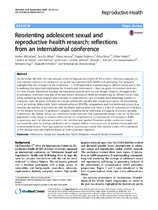| dc.contributor.author | Michielsen, Kristien | |
| dc.contributor.author | De Meyer, Sara | |
| dc.contributor.author | Ivanova, Olena | |
| dc.contributor.author | Anderson, Ragnar | |
| dc.contributor.author | Decat, Peter | |
| dc.contributor.author | Herbiet, Céline | |
| dc.contributor.author | Kabiru, Caroline W. | |
| dc.contributor.author | Ketting, Evert | |
| dc.contributor.author | Lees, James | |
| dc.date.accessioned | 2018-06-28T12:21:57Z | |
| dc.date.available | 2018-06-28T12:21:57Z | |
| dc.date.issued | 2016 | |
| dc.identifier.citation | Michielsen, K. et al. Reorienting adolescent sexual and reproductive health research: reflections from an international conference. Reproductive Health, 13(3) | en_US |
| dc.identifier.issn | 1742-4755 | |
| dc.identifier.uri | http://dx.doi.org/10.1186/s12978-016-0117-0 | |
| dc.identifier.uri | http://hdl.handle.net/10566/3841 | |
| dc.description.abstract | On December 4th 2014, the International Centre for Reproductive Health (ICRH) at Ghent University organized an
international conference on adolescent sexual and reproductive health (ASRH) and well-being. This viewpoint
highlights two key messages of the conference - 1) ASRH promotion is broadening on different levels and 2) this
broadening has important implications for research and interventions – that can guide this research field into
the next decade. Adolescent sexuality has long been equated with risk and danger. However, throughout the
presentations, it became clear that ASRH and related promotion efforts are broadening on different levels: from
risk to well-being, from targeted and individual to comprehensive and structural, from knowledge transfer to
innovative tools. However, indicators to measure adolescent sexuality that should accompany this broadening
trend, are lacking. While public health related indicators (HIV/STIs, pregnancies) and their behavioral proxies (e.g.
condom use, number of partners) are well developed and documented, there is a lack of consensus on indicators
for the broader construct of adolescent sexuality, including sexual well-being and aspects of positive sexuality.
Furthermore, the debate during the conference clearly indicated that experimental designs may not be the only
appropriate study design to measure effectiveness of comprehensive, context-specific and long-term ASRH
programmes, and that alternatives need to be identified and applied. Presenters at the conference clearly
expressed the need to develop validated tools to measure different sub-constructs of adolescent sexuality and
environmental factors. There was a plea to combine (quasi-)experimental effectiveness studies with evaluations
of the development and implementation of ASRH promotion initiatives. | en_US |
| dc.language.iso | en | en_US |
| dc.publisher | BioMed Central | en_US |
| dc.rights | © 2016 Michielsen et al. Open Access This article is distributed under the terms of the Creative Commons Attribution 4.0
International License (http://creativecommons.org/licenses/by/4.0/), which permits unrestricted use, distribution, and
reproduction in any medium, provided you give appropriate credit to the original author(s) and the source, provide a link to
the Creative Commons license, and indicate if changes were made. The Creative Commons Public Domain Dedication waiver
(http://creativecommons.org/publicdomain/zero/1.0/) applies to the data made available in this article, unless otherwise stated. | |
| dc.subject | Adolescents | en_US |
| dc.subject | Sexual and reproductive health | en_US |
| dc.subject | Evaluation research | en_US |
| dc.subject | Social determinants | en_US |
| dc.title | Reorienting adolescent sexual and reproductive health research: reflections from an international conference | en_US |
| dc.type | Article | en_US |
| dc.privacy.showsubmitter | FALSE | |
| dc.status.ispeerreviewed | TRUE | |
| dc.description.accreditation | ISI | |

